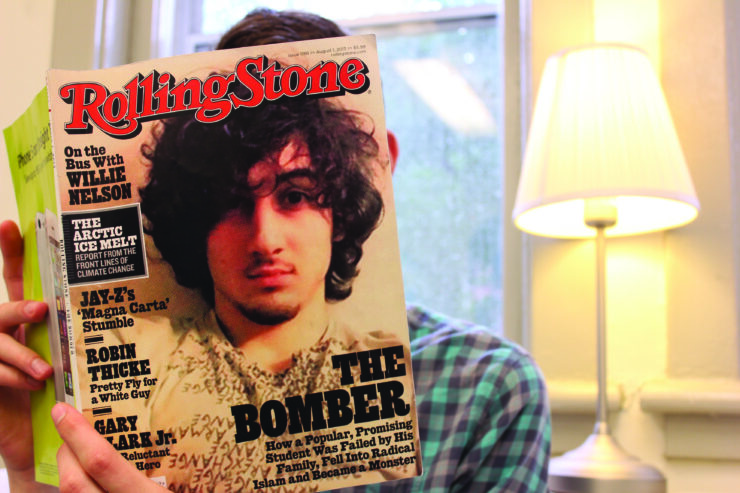Photo illustration by Adam Feibel
THE AUGUST COVER of Rolling Stone may be the most talked about in the magazine’s recent history, but will the story that accompanies it be one of the least read?
We’ve all heard that a picture is worth a thousand words, but what happens when a picture provokes such a negative response that the words that go with it are neglected completely?
Rolling Stone’s most recent issue features an 11-page in-depth look into the life and crime of Dhzhokhar Tsarneav—the youngest of the Boston Marathon bombers—and a cover image of the bushy-haired 19-year-old. Even before the issue hit newsstands, much of the public was in an uproar.
“I can’t think of another instance in which one has glamorized the image of an alleged terrorist. This is the image of a rock star,” said Kathleen Hall Jameison, a communications professor at the University of Pennsylvania in an interview with the CBC. “This is the image of someone who is admired, of someone who has a fan base, of someone who we are critiquing as art.”
Is it, though? The image is a self-portrait pulled from Tsarneav’s personal Twitter page and has been widely used by media outlets all over the world. The New York Times ran the exact same image on their front page on May 5 and incited much less public outcry. So, why the hoopla when Rolling Stone did the same?
Some say the magazine overreached; it is, after all, an entertainment magazine, right?
Not quite. Rolling Stone began to immerse itself in the world of politics and current affairs in the ‘70s back when legendary journalist Hunter S. Thompson was a contributor. Since then, the magazine has featured cover stories on everyone from President Bill Clinton to Charles Manson, and they’ve done it because they believe that getting to know the prominent figures in our world—whether they’re leaders or villains—is vital.
You can’t assume what has been written about Tsarneav just by looking at the cover. You have to read the 12,000 words inside to understand why he is featured at all. You could even find the reason by reading the mere 107-word explanation by Rolling Stone editors that precedes the article.
“Our hearts go out to the victims of the Boston Marathon bombing, and our thoughts are always with them and their families. The cover story we are publishing this week falls within the traditions of journalism and Rolling Stone’s long-standing commitment to serious and thoughtful coverage of the most important political and cultural issues of our day. The fact that Dzhokhar Tsarnaev is young, and in the same age group as many of our readers, makes it all the more important for us to examine the complexities of this issue and gain a more complete understanding of how a tragedy like this happens.” —The Editors (Rolling Stone)
The question we should be asking in regards to the controversy is this: are we, as a society, consuming our media in a responsible manner?
The Internet has made information more readily available and has reduced the time required for us to process it. This will often lead to a fast-talking and under-informed recycling of thoughts, which means the world isn’t having an intelligent, well-informed conversation—it’s just babbling. Hundreds (perhaps thousands) of people who may not have read the article—titled “Jahar’s World”—and may never intend to read the article can publicly express how they feel about the cover photo. And apparently, they’re pissed.
Some have argued that Rolling Stone should have featured stories on the victims of the Boston Marathon—and these arguments are not wrong—but we cannot ignore the fact that the victims of this crime were random and not individually targeted. Do we not feel it could be helpful to investigate why someone would do something like this? Are we willing to just slap the terrorist label on this man and move on?
We need to learn to spend more time with the things that make us uncomfortable than the 30 seconds it takes to rage-tweet a half-cocked opinion. We need to look at every side of a story and at least attempt to understand them in order to move forward. Choosing ignorance does not lead to change.
editor@thefulcrum.ca





